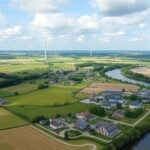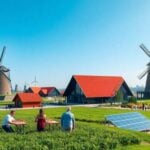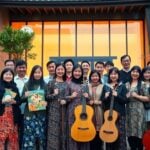In the realm of scholarships, fellowships, grants, and investments, the concept of community impact is paramount. Funders are increasingly looking for projects that not only promise individual benefits but also contribute positively to the broader community. This shift in focus underscores the need for applicants to articulate how their initiatives will create meaningful change.
A well-defined community impact can enhance the appeal of a proposal, making it more likely to secure funding. When crafting a proposal, it is essential to recognize that funders are not merely investing in a project; they are investing in a vision for a better community. This means that applicants must clearly outline how their work will address specific community needs, improve quality of life, or foster social cohesion.
For instance, a fellowship aimed at supporting local artists could emphasize how the arts contribute to community identity and economic development. By framing proposals around community impact, applicants can resonate with funders’ values and priorities, thereby increasing their chances of success.
Identifying Key Stakeholders and Partners
Introduction to Stakeholder Identification
Identifying key stakeholders and potential partners is a critical step in developing a successful proposal. Stakeholders can include community members, local organizations, government agencies, and businesses that have a vested interest in the project’s outcomes. Engaging these groups early in the process not only helps to refine the proposal but also builds a network of support that can be invaluable during implementation.
Benefits of Collaboration
Collaboration with established organizations can lend credibility to a proposal and demonstrate a commitment to community engagement. For example, if an applicant is proposing a health initiative, partnering with local health departments or non-profits can provide access to resources and expertise that strengthen the proposal. Additionally, these partnerships can help in gathering letters of support, which are often required by funders.
Building a Strong Proposal
By showcasing a collaborative approach, applicants can illustrate a shared commitment to achieving the project’s goals, making their proposals more compelling. This approach not only enhances the proposal’s credibility but also demonstrates the applicant’s ability to work with various stakeholders to achieve a common objective.
Enhancing Proposal Success
Ultimately, engaging with stakeholders and partners is essential to developing a successful proposal. By building a strong network of support and showcasing a collaborative approach, applicants can increase their chances of securing funding and achieving their project’s goals.
Collecting Data and Evidence of Impact
Data collection is an essential component of any successful grant proposal. Funders want to see evidence that the proposed project will have a measurable impact on the community. This requires applicants to gather both qualitative and quantitative data that supports their claims.
For instance, if an applicant is proposing an educational program aimed at improving literacy rates among children, they should include statistics on current literacy levels in the target area, as well as research that demonstrates the effectiveness of similar programs. Moreover, incorporating testimonials or case studies from previous initiatives can provide powerful evidence of potential impact. Real-world examples can illustrate how similar projects have succeeded in other communities, thereby reinforcing the feasibility of the proposed initiative.
By presenting a well-rounded collection of data and evidence, applicants can build a strong case for why their project deserves funding.
Creating a Clear and Measurable Plan for Impact
A clear and measurable plan is crucial for demonstrating how a project will achieve its intended outcomes. This involves setting specific goals and objectives that are aligned with the overall mission of the project. Funders appreciate proposals that outline not only what will be done but also how success will be measured.
This could include metrics such as the number of participants served, improvements in specific skills or knowledge areas, or changes in community conditions. In addition to defining goals, it is important to establish a timeline for implementation and evaluation. A well-structured timeline helps funders understand how the project will unfold over time and when they can expect to see results.
For example, if an applicant is proposing a mentorship program for at-risk youth, they should detail each phase of the program—from recruitment and training of mentors to ongoing support and evaluation of participant outcomes. By providing a comprehensive plan that includes measurable objectives and timelines, applicants can instill confidence in funders regarding their ability to execute the project effectively.
Engaging the Community in the Proposal Process
Engaging the community throughout the proposal process is not only beneficial for gathering insights but also fosters a sense of ownership among community members. When individuals feel invested in a project, they are more likely to support it and participate actively once it is implemented. This engagement can take many forms, from surveys and focus groups to community meetings where ideas and feedback are solicited.
Involving community members in the proposal process also enhances its relevance and effectiveness. For instance, if an applicant is developing a program aimed at addressing food insecurity, consulting with local residents about their needs and preferences can lead to more tailored solutions. Furthermore, showcasing community involvement in the proposal can strengthen its appeal to funders who prioritize grassroots engagement.
By demonstrating that the project has been shaped by those it aims to serve, applicants can create a compelling narrative that highlights both community support and alignment with local priorities.
Communicating the Benefits of the Fellowship to the Community
Introduction to Effective Communication
Effectively communicating the benefits of a fellowship or grant to the community is essential for garnering support and enthusiasm for the project. This involves not only articulating what the project aims to achieve but also how it will directly benefit community members. Clear communication helps demystify the proposal process and fosters transparency, which can build trust among stakeholders.
Emphasizing Community Benefits
For example, if an applicant is seeking funding for an environmental initiative, they should emphasize how this project will lead to cleaner air and water, improved public spaces, or enhanced recreational opportunities for residents. By highlighting these benefits, applicants can demonstrate the positive impact of their project on the community.
Utilizing Communication Channels
Utilizing various communication channels—such as social media, community newsletters, or local events—can help reach diverse audiences and ensure that information about the project is widely disseminated. This multi-channel approach allows applicants to tailor their message to different groups and increase the visibility of their project.
Rallying Community Support
By effectively communicating benefits, applicants can rally community support and create a sense of collective investment in the proposed initiative. This, in turn, can lead to a stronger, more sustainable project that benefits both the community and the applicant, fostering a positive and lasting impact.
Addressing Potential Challenges and Risks
Every project comes with its own set of challenges and risks, and addressing these head-on in a proposal demonstrates foresight and preparedness. Funders appreciate applicants who acknowledge potential obstacles and outline strategies for mitigating them. This could include identifying possible funding shortfalls, logistical challenges, or resistance from certain community groups.
For instance, if an applicant is proposing a new educational program in a school district facing budget cuts, they should address how they plan to secure additional funding or resources to sustain the initiative. Providing contingency plans shows funders that applicants are not only optimistic about their projects but also realistic about potential hurdles. By proactively addressing challenges and risks, applicants can enhance their credibility and reassure funders that they are equipped to navigate complexities.
Demonstrating Sustainability and Long-Term Impact
Finally, demonstrating sustainability is crucial for securing funding for any initiative. Funders want assurance that projects will not only achieve short-term goals but also have lasting effects on the community. This requires applicants to outline plans for sustaining their initiatives beyond the initial funding period.
Sustainability can take many forms—whether through securing ongoing funding from other sources, building partnerships with local organizations for continued support, or developing revenue-generating components within the project itself. For example, if an applicant is proposing a community garden initiative funded by a grant, they should discuss plans for generating income through produce sales or workshops that could help sustain operations over time. Additionally, illustrating long-term impact involves setting up mechanisms for ongoing evaluation and adaptation of the project based on community needs and feedback.
By demonstrating a commitment to sustainability and long-term impact, applicants can reassure funders that their investment will yield significant returns for the community well into the future. In conclusion, navigating the landscape of scholarships, fellowships, grants, loans, or investments requires careful planning and strategic thinking. By understanding the importance of community impact, engaging stakeholders, collecting data, creating measurable plans, involving the community in proposals, communicating benefits effectively, addressing challenges proactively, and demonstrating sustainability, applicants can significantly enhance their chances of success in securing funding for their initiatives.


























